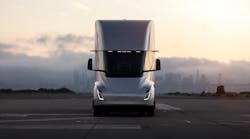Tesla CEO Elon Musk took to Twitter on Oct. 6 to announce the start of Tesla Semi Truck production with deliveries to PepsiCo’s private fleet on Dec. 1.
Musk, who tweeted that the electric semi has a 500-mile range and is “super fun to drive,” initially unveiled the company’s long-teased electric Class 8 truck back in November 2017.
The Tesla Semi was supposed to go into production by 2019, but the timeline has been pushed back multiple times due to various reasons—most recently because of parts shortages. In 2020, Musk claimed that all engineering work on the semi had been completed and that Tesla expected to begin deliveries in 2021. The availability of battery cells was the only issue limiting the vehicle’s production, Musk said at the time. Months later, Tesla didn’t provide much of a progress report except to say the semi was in development.
See also: Tesla receives orders from four companies for electric truck
PepsiCo, which ranks No. 2 on the FleetOwner 500: Top Private Fleets of 2022 list, said on its website that as the company “continuously explores emerging technologies that will position us for the future, we made an initial reservation for 100 all-electric Class 8 tractors from Tesla. These will be deployed across both our snacks and beverage businesses.” Additionally, Pepsi said its Frito-Lay division will deploy more than 40 electric vans in North America in 2022 to evaluate how best to leverage electric vehicles and technologies moving forward.
According to a Reuters report, the Tesla Semi is expected to cost $180,000, although it would qualify for a tax break of up to $40,000 under a U.S. subsidy program approved by the U.S. Senate.
Overall, the industry has been skeptical about Musk’s claims regarding the Tesla Semi’s production timelines and range capabilities.
“Elon Musk stopped bragging about building a 600-mile-charge truck. You haven’t heard that in two years because that is a physical impossibility,” transportation futurist Garry Golden told fleet leaders gathered back in May for the Solera Outlook 2022 conference. The best you’ll get on a charge—which will take you two to four hours to get to 80%—is a 200-mile trip.”
“If you want the signals, you don’t look to see what Elon Musk is saying. You look at what the Tier 1 system integrators are building,” Golden added.



